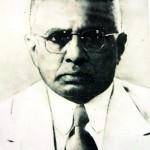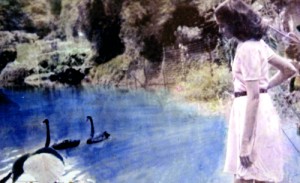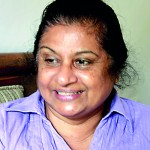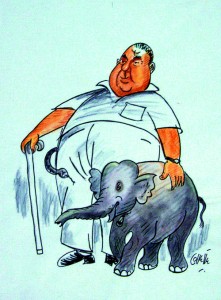Childhood days in the zoo
The father-son tale inextricably linked to the Dehiwela National Zoological Gardens drew a huge response.
Headlined ‘Once it was David’s big garden with lots of animals’ published in the PLUS on March 30, it was about Major Aubrey Neil Weinman the second Superintendent and first Director of the Zoo through the eyes of his son, David.

Fred Ekanayake Goonasingha
It brought about a call from Hema Wijayasinghe who lives in Battaramulla who asked us: “Did you know that my grandfather was the first Superintendent of the Zoo?” after which that tale too unfolded.
Her Seeya was Frederick Ekanayake Goonasingha, the eldest brother of Alexander Ekanayake Goonasingha, aka the Labour Leader of colonial Ceylon whose statue now occupies the boundary between Pettah and Goonasinghapura.
Fred had been the zoo’s first Superintendent from 1936-1947.
Hema brings to life her Seeya through the words of her mother, Srikantha, the only daughter of Frederick Goonasingha, among six sons, and who was his favourite. Hema also garners information of that time from pieces her Uncle Kesara (one of Fred’s sons) wrote to the newspapers.
Those tales begin with a strong friendship between her Seeya and whom her mother called John Harganburg (a search on the internet says it’s Hagenbeck) from Germany, an animal collector.
Life, however, changed dramatically with the outbreak of World War II and Hema recalls her mother telling her that John returned to Germany, entrusting Seeya with his 50-acre property with animals at Dehiwela.
 It is Kesara’s memories that Hema picks on then to create an image of this privately-run Zoological Gardens Co. Ltd., which had beautifully laid out ponds, terraces and shade trees. Admission was by paying 10 cents for adults and five cents for children.
It is Kesara’s memories that Hema picks on then to create an image of this privately-run Zoological Gardens Co. Ltd., which had beautifully laid out ponds, terraces and shade trees. Admission was by paying 10 cents for adults and five cents for children.
With Fred not being able to manage the property and also seeing the vital need for a National Zoo, he had turned to his younger brother, A.E. Goonasingha, with a request to take it up with the government as he was a Member of the State Council.
Earlier, Fred had been in show business during the time of the silent movies, being in charge of the Old Olympia Cinema on Darley Road. After his stint at the Zoo, he had joined up with a relative, John de Silva to stage popular Sinhala plays and dramas at the Tower Hall. He is also credited with opening Darley House and pioneering the International Buddhist Brotherhood.
With the Zoological Gardens not being an unknown quantity to people of eminence in Ceylon, such as Governor Sir Andrew Caldecott, Lady Caldecott and daughter (frequent visitors there) and S.W.R.D. Bandaranaike, the state had decided to take it over.

Hema: Recalling her mother’s anecdotes
Named the National Zoological Gardens of Ceylon, Fred had been installed as its first Curator-Superintendent and he had set about exchanging animals with other zoos to bring in rare species such as the rhinoceros, tapir, nilgai, giant tortoises, birds and reptiles, while the mini zoo at the National Museum had also been transferred here.
The elephant dance circus had become an added attraction with elephant and pony rides being enjoyed by visitors. The pavilion was where ballroom dancing and other festivities took place with the Police Band being in attendance on Sunday, Kesara had recalled.
Hema’s late mother’s memories of the Zoo had been vivid. Numerous had been the stories that she regaled her children with……..moving into the bungalow within the Zoo premises as a little girl, where there were hordes of domestic helpers as well as animal keepers.
A night which had traumatized the little girl had been the insistent trumpeting of an elephant. Instinctively knowing that something was amiss, Fred who had been ready for bed had decided to go see what was wrong. “As he hurriedly donned a dressing gown over his night-clothes, my mother had clung to the gown’s cord wailing that she too wished to go with him, a tearful request he just couldn’t refuse,” says Hema.
Walking up to the trumpeting elephant, there had been a “shocking” sight for father and daughter — a huge python wrapped around the foot of the elephant. What was needed was a whistle from the Superintendent for the keepers to hurry to the spot, recounts Hema who had heard this story over and over again from her Amma.
Ultimately it was ‘Nai Jamis’ who knew mantra who could get the python to untangle itself and leave the elephant in peace, she says.
Vivid had been the images in her mother’s mind about her “stay” at the Zoo. Their mornings would be greeted by a cassowary which had taken lodging on a chair in their open verandah and would kick anyone who got close. The only thing that it was frightened of was the ekel broom which had to be brandished for it to make a hurried exit.
Sometimes it would be an ostrich and Srikantha’s children would make faces when she told them how during the war, when hard times descended, ostrich eggs (“loku biththara”) would make a good meal with rotti.
The war had also brought about other issues. With air-raid sirens screaming and British-Japanese dogfights on, the fallout that Easter Sunday in 1942 had made the lions and tigers restless. It was then that Major L.V. Gooneratne who had been Chief Air Raid Warden had made arrangements with Fred to protect the animals as well as dig a trench for the people.
Memories also abound of chaos and fright reigning when the black panther and the baboon got loose and the time when Fred’s hand was bitten by a lion, sending him to hospital for several days. The honour then of taking Governor Caldecott around the Zoo had fallen on Fred’s wife, which she carried out with aplomb.
Near misses of canings by Fred had also been seared into his children’s memories. There had been dire warnings that Srikantha and her six brothers should not go anywhere near the “nana pokuna” (bathing pond) but this is exactly what they did when their father had a catnap in the afternoon.
Blowing at the variety of colourful feathers they had picked up from all over the Zoo, first one brother, then the other brother followed by Srikantha as well as the maid who was looking after her had fallen into the pond. The unenviable task of jumping in and rescuing them had fallen to keeper Dionis. With Srikantha pleading with their father, they had narrowly missed a few whacks from the wewela (cane).
Feathers had also been the barter items for the children who would exchange them for stamps and coins with sailors who were frequent visitors to the Zoo.
The sailors had also given the boys cigarettes which they would smoke surreptitiously in some corner, knowing very well that there would be no dilution of the wrath of their father if he caught them.
For Srikantha, her fondest memories had been picking some flowers from the Zoo garden, placing them in a basket and offering them to royal and important visitors who included the Duke of Gloucester, brother of King George VI, and also Sir Geoffrey Layton who was Commander-in-Chief of Ceylon during the war.
Her proudest moment in more recent times before her death when those childhood years were just a memory had been taking her grandchildren to the Zoo.
A long forgotten bond seemed to have sparked off recognition in ‘Lechchimie’ under whose stomach she had crawled so many times, those long years ago……..when it trumpeted a salute, Srikantha had been certain that an elephant never forgets.
| Sketch from the past
An e-mail to David Weinman in Sabah, Malaysia, from Kandy soon after the Zoo story was published in the Sunday Times included an interesting sketch. It was from Shamil Peiris who stated that in his collection of Sri Lankan art, there was a sketch by Aubrey Collette, famous artist of the 1943 Group which included the likes of George Keyt, Ivan Peries and Richard Gabriel. The sketch by Collette is of David’s father – Major Aubrey Neil Weinman.
|



